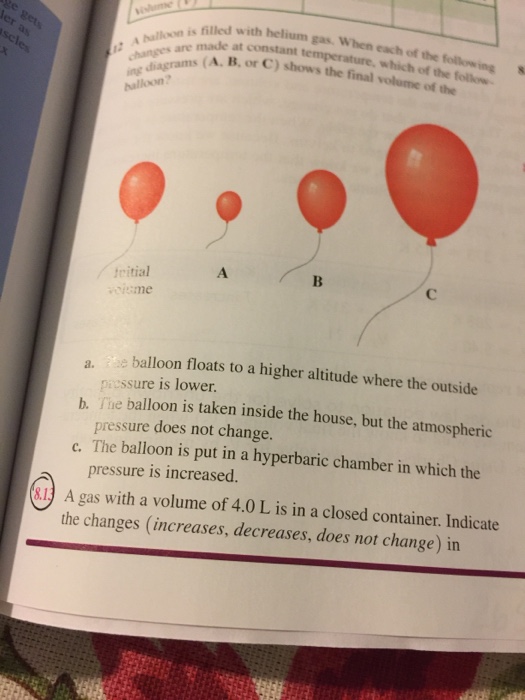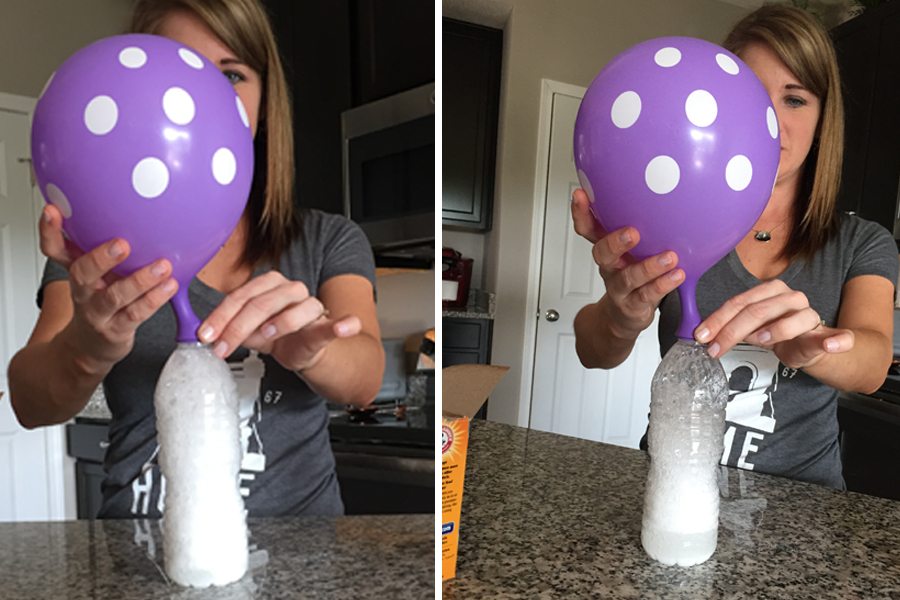- A weather balloon is filled with helium to a volume of 1.61 L at 734 torr. We’re being asked to determine the volume of the gas sample after it has been released and its pressure has dropped to 0.844 atm. Recall that the ideal gas law is: PV = nRT. The pressure and volume of a gas are related to the number of moles, gas constant and temperature.
- Solution for A light balloon is filled with 397 m3 of helium at atmospheric pressure. (a) At 0°C, the balloon can lift a payload of what mass?
Helium The Answer to Why: (source: thenakedscientists.com) In order to get a floating balloon you want a gas which is as light as possible. Helium is quite a lot lighter than air weight. It's about and eighth of the density of air.
We’ve all let go of a latex helium balloon, whether intentionally or by accident, but what happens once that helium balloon soars out of our vision?
Why does a helium balloon float?
Helium, which has a mass of 4.00 g/mol, has a density of 0.164 g/l. Thus, a one-liter balloon of helium can lift a mass of (1.18-0.164) = 1.02 g. Of course, this would include the mass of the balloon skin itself, and we are assuming that the pressure inside the balloon is not significantly greater than the surrounding pressure of 1 atm. A balloon filled with helium gas at 20C occupies 4.91 L at 1.00 atm. The balloon is immersed in liquid nitrogen at -196C, while the pressure is raised to 5.20 atm. What is the volume of the balloon in the liquid nitrogen?
A filled helium balloon rises because of the simple fact that helium is lighter than air.
What happens to the helium balloon as it rises?
As altitude increases, the density of the atmosphere decreases. So as a latex helium balloon rises, the outside air pressure diminishes, while the pressure from inside of the balloon remains the same. This causes the elastic material of the latex helium balloon to expand.
A Balloon Is Filled With Helium Gas. (figure 1)


As the latex expands, the helium balloon increases in volume, thereby increasing its buoyancy. The more a balloon’s material can safely expand, the higher it will rise.
If you need helium for your balloons, go here and get a free helium quote from Zephyr.
How high can a helium balloon go?
This depends largely on the material of the helium balloon. One made of a stronger latex will be able to expand (and ascend) more than one that is made of a weaker latex.
In a 1992 study of a test of toy balloons for the Federal Department of Aviation, researchers found that latex helium balloons can rise to an altitude of 5.7 miles to 6.6 miles before popping.
What happens when the helium balloon pops?
Inflate a helium balloon indoors until it pops and you’ll be left with relatively large pieces of rubber. Do it 5 miles up in the air and something quite different happens.
When a latex helium balloon reaches the low temperatures within that 5-6 mile altitude range, it will actually freeze. The elasticity of latex decreases significantly in low temperatures, so the helium balloon that was expanding suddenly becomes incredibly brittle.
A Balloon Is Filled With Helium Gas Prices
What happens next is not the traditional pop that you and I are used to seeing, but instead something simply called “shattering.” The helium balloon breaks in a manner that is similar to smashing a mirror, and all that is left are very small pieces of cold latex that sprinkle back down to the planet.
(It’s said that these shattered pieces are too small to pose any threats to animals because they are easily passed through the system if ingested.)
Variables
Of course, there are exceptions. Variables that can throw a hitch in these rules include poorly manufactured or flawed latex, latex that is unable to expand significantly or expands too quickly, helium balloons that are not fully inflated, or the altitude and climate of the place from which the balloon was released.
What about a foil helium balloon?
Due to their shattering capability, professionals will only use 100% biodegradable latex balloons during intentional releases so that large pieces of material are not left littering the ground or water. This latex biodegrades in the same amount of time as a fallen leaf.
But accidental or unprofessional releases of other balloons like foil do happen.
In the same 1992 study referenced earlier, mylar balloons rose only to about 3,280 feet, with some reaching a maximum of 1.5 miles, where they would eventually either burst open or simply “lose their lift” and glide back down to Earth.
Helium Tanks Cleveland
Source: Test of toy balloons performed for Federal Department of Aviation via balloonhq.com
